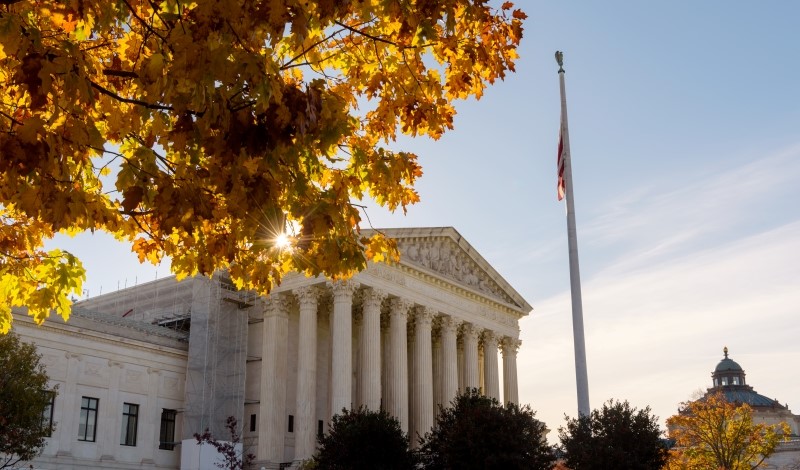
The Administrative Procedure Act empowers courts—not agencies—to decide a statute’s single best meaning.
In Loper Bright Enterprises v. Raimondo, decided together with its companion case Relentless v. Department of Commerce, the U.S. Supreme Court announced a sea change in administrative law: “Chevron is overruled.” To the majority, this decision marks the end of an era of judicial abdication. To the dissenters, overruling Chevron amounts to a massive judicial power grab. What is certain is that by overruling a decision that had been cited in over 18,000 federal court opinions, the Supreme Court has handed down one of the most important decisions in the history of administrative law.
In 1984, a six-justice quorum of the Supreme Court decided Chevron U.S.A. v. Natural Resources Defense Council. In his opinion for the Chevron Court, Justice John Paul Stevens announced a new “two-step” framework for resolving disputes over the scope of an agency’s statutory authority. Under this standard, a court must first consider “the question whether Congress has directly spoken to the precise question at issue.” This first question should be “the end of the matter” if “the intent of Congress is clear,” because courts “must give effect to the unambiguously expressed intent of Congress.” At this stage, courts must employ “the traditional tools of statutory construction” to ascertain whether “Congress had an intention on the precise question at issue.”
It was the second step that would make Chevron a landmark case. If a court finds that “Congress has not directly addressed the precise question at issue,” then, under Chevron, the agency’s interpretation can become determinative. In this situation, Chevron instructed that a court should “not simply impose its own construction on the statute, as would be necessary in the absence of an administrative interpretation.” Instead, courts should ask “whether the agency’s answer is based on a permissible construction of the statute.” If the answer is “yes,” Chevron required that the court defer to the agency’s interpretation.
In Loper Bright, Chief Justice John Roberts wrote for a six-justice majority. His opinion homed in on the text of the Administrative Procedure Act (APA), which requires that “the reviewing court shall decide all relevant questions of law” in agency cases. The Court held that this text “means what it says,” and therefore the “deference that Chevron requires of courts reviewing agency action cannot be squared with the APA.”
The majority reasoned that for a court to “decide” a question of law, that court “must exercise independent judgment in determining the meaning of statutory provisions.” The majority concluded that “Chevron defies the command of the APA” because it “requires a court to ignore, not follow, ‘the reading the court would have reached’ had it exercised its independent judgment as required by the APA.”
The most important premise underlying the Loper Bright majority’s reasoning is that there is always a single best reading of a statute. “In an agency case as in any other, …there is a best reading all the same—‘the reading the court would have reached’ if no agency were involved.” The logic of the Court’s opinion necessarily relied on this premise—that “statutes, no matter how impenetrable, do—in fact, must—have a single, best meaning.” And if that premise is accepted, then it “makes no sense to speak of a ‘permissible’ interpretation that is not the one the court, after applying all relevant interpretive tools, concludes is best. In the business of statutory interpretation, if it is not the best, it is not permissible.”
In defending Chevron, the government had argued that Congress implicitly delegates interpretive authority to agencies when it leaves ambiguities in statutes. On that view, Chevron simply implements congressional intent.
But the majority rejected this argument by looking, once again, to the text of the APA. As the Court noted, the APA “does mandate that judicial review of agency policymaking and factfinding be deferential,” and thus “Congress surely would have articulated a similarly deferential standard applicable to questions of law had it intended to depart from the settled pre-APA understanding that deciding such questions was ‘exclusively a judicial function.’” In other words, Congress knew how to mandate deferential review when it drafted the APA, and it chose not to do so for questions of law.
Looking beyond the APA, the Court rejected all of the government’s proposed reasons why Congress would supposedly prefer that courts defer to agencies.
First, the Court addressed the theory that “Congress must generally intend for agencies to resolve statutory ambiguities because agencies have subject matter expertise regarding the statutes they administer.” The Court insisted that judges do not need pre-existing expertise to make an informed legal judgment in technical cases, since “the parties and amici in such cases are steeped in the subject matter,” and “reviewing courts have the benefit of their perspectives.” Agencies, just like any other party, can use their technical expertise to persuade a court by making convincing arguments in their briefs. For these reasons, the Court found the better presumption to be “that Congress expects courts to do their ordinary job of interpreting statutes, with due respect for the views of the Executive Branch.”
Next, the Court considered the government’s argument that “deferring to agencies purportedly promotes the uniform construction of federal law.” Once again, this theory could not hold up under the majority’s foundational premise that questions of administrative law have a single correct answer and that judges are tasked with determining that right answer. In many instances, the government will select an interpretation that is not the court’s best view of the law, and “there is little value in imposing a uniform interpretation of a statute if that interpretation is wrong.”
Finally, the Court reiterated that Chevron is about legal questions, not policy questions: “It is reasonable to assume that Congress intends to leave policymaking to political actors. But resolution of statutory ambiguities involves legal interpretation.” The majority opinion reassured that overruling Chevron will not change how courts review statutes that truly delegate policymaking decisions to agencies: “Some statutes ‘expressly delegate’ to an agency the authority to give meaning to a particular statutory term. … Others empower an agency to prescribe rules to ‘fill up the details’ of a statutory scheme…or to regulate subject to the limits imposed by a term or phrase that ‘leaves agencies with flexibility,’ …such as ‘appropriate’ or ‘reasonable.’” In those situations, courts should continue to “effectuate the will of Congress… by recognizing constitutional delegations,” just as they have before.
In both Loper Bright and Relentless, the challengers had made not only statutory arguments against Chevron, relying on the APA, but also constitutional arguments, relying on Article III. Notably, the majority opinion relied solely on the APA for its holding, declining to hold that Article III of the Constitution requires non-deferential review of questions of law. Although the opinion included several references to the Framers and their motivations for granting Article III judges life tenure and salary protection, the Court never went so far as to suggest that Chevron deference violated Article III’s command that the “judicial power of the United States” be vested in the federal courts.
The Court may have declined to reach this constitutional question simply because it was unnecessary to do so; when a case can be decided on statutory grounds rather than constitutional grounds, the Court will normally take that route. But another possibility is that the majority was implicitly responding to the government’s and dissent’s claim that Congress in fact wants courts to defer to agencies. If that claim of congressional intent is in fact true, nothing in the majority opinion prevents Congress from reinstating Chevron deference tomorrow. Congress need only amend the portion of the APA vesting all decisions of law in the reviewing court and explicitly add a rule of deference.
In a solo concurrence, Justice Clarence Thomas briefly noted that he believes Chevron deference violates Article III of the Constitution. In another solo concurrence, Justice Neil Gorsuch seemed sympathetic to that view, writing that under Chevron “authorities long thought reserved for Article III are transferred to Article II.” The views of the other four justices in the majority on this constitutional question remain unknown, and the question would be likely to arise only if Congress does in fact mandate deferential review in the APA or another statute.
Justice Gorsuch’s concurrence also addressed his views on stare decisis and his considerations when evaluating a precedent. Besides the obvious point that, in the view of Justice Gorsuch and the majority, Chevron was wrongly decided, two other factors were key to his view that Chevron should be overruled. Justice Gorsuch argued that “Chevron deference runs against mainstream currents in our law regarding the separation of powers, due process, and centuries-old interpretive rules.” And he further argued that the Chevron two-step arose from “stray statements” in the Chevron opinion that were in tension with “more considered language in that same decision.”
Justice Elena Kagan dissented, joined by Justices Sonia Sotomayor and Ketanji Brown Jackson. Justice Kagan rejected the majority’s foundational premise that the types of questions decided under Chevron have only one best answer. In Justice Kagan’s view, it is often the case that “a statutory phrase has more than one reasonable reading. And Congress has not chosen among them: It has not, in any real-world sense, ‘fixed’ the ‘single, best meaning’ at ‘the time of enactment.’”
Justice Kagan believes that answering the types of questions previously found “ambiguous” under Chevron “does not mainly demand the interpretive skills courts possess. Instead, it demands one or more of: subject-matter expertise, long engagement with a regulatory scheme, and policy choice.” And Justice Kagan’s view that these are policy choices, not legal decisions, informed her view of what Congress would likely want courts to do. Her dissent argued that Chevron deference “rests on a presumption about legislative intent.” As Justice Kagan put it, Congress knows that regulatory “statutes will inevitably contain ambiguities that some other actor will have to resolve, and gaps that some other actor will have to fill. And it would usually prefer that actor to be the responsible agency, not a court.”
Justice Kagan also found the text of the APA perfectly consistent with this presumption. Looking at the APA text on which the majority relied, Justice Kagan argued that the APA “does not prescribe a de novo standard of review” for legal questions and that a court just as much “decides” a legal question when it uses a deferential standard, as Chevron called for.
Ultimately, the majority’s implicit response to this criticism is that if Congress disagrees with the majority’s view, the ball remains in Congress’s court. Not only may Congress amend the APA, it may also draft any individual statute so that its “best reading…is that it delegates discretionary authority to an agency.” Or, if Congress disagrees with the policy that results from a court’s interpretation, it is “always free to act by revising the statute.”
The Court’s opinion in Loper Bright sets no limitations on Congress’s ability to explicitly delegate policy choices to the Executive Branch (the extent to which such delegations may be limited by the nondelegation doctrine is a question for another case). Instead, the opinion has ended what was, in the majority’s view, a harmful legal fiction that prevented courts from doing their jobs: “By forcing courts to…pretend that ambiguities are necessarily delegations, Chevron does not prevent judges from making policy. It prevents them from judging.”
This essay is part of a series, titled The Supreme Court’s 2023-2024 Regulatory Term.




